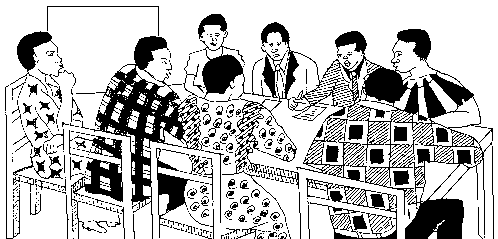Tweet
Translations:
'العربية / Al-ʿarabīyah
Bahasa Indonesia
Català
中文 / Zhōngwén
English
Español
Filipino/Tagalog
Français
Ελληνικά / Elliniká
हिन्दी / Hindī
Italiano
بهاس ملايو / Bahasa Melayu
Português
Română
Српски / Srpski
Türkçe
Other formats:
Other Pages:
Modules
Site Map
Key Words
Contact
Utility Documents
Useful Links
SIXTEEN ELEMENTS
OF COMMUNITY STRENGTH
by Phil Bartle, PhD
Workshop Handout
Altruism. The proportion of, and degree to which, individuals are ready to sacrifice benefits to themselves for the benefit of the community as a whole (as reflected in degrees of generosity, individual humility, personal sacrifice, communal pride, mutual supportiveness, loyalty, concern, camaraderie, sister/brotherhood);
Common Values. The degree to which members of the community share values, especially the idea that they belong to a common entity that supersedes the interest of members within it;
Communal Services. Facilities and services (such as roads, markets, potable water, access to education, health services), their upkeep (dependable maintenance and repair), sustainability, and the degree to which all community members have access to them;
Communications. Within a community, and between itself and outside, communication includes roads, electronic methods (eg telephone, radio, TV, InterNet), printed media (newspapers, magazines, books), networks, mutually understandable languages, literacy and the willingness and ability to communicate (which implies tact, diplomacy, willingness to listen as well as to talk) in general;
Confidence. Although expressed as confidence in individuals, how much confidence is shared among the community as a whole? eg an understanding that the community can achieve what ever it wishes to do, positive attitudes, willingness, self motivation, enthusiasm, optimism, self-reliant rather than dependency attitudes, willingness to fight for its rights, avoidance of apathy and fatalism, a "vision" of what is possible;
Context (political and administrative). An environment that supports strengthening includes political (including the values and attitudes of the national leaders, laws and legislation) and administrative (attitudes of civil servants and technicians, as well as Governmental regulations and procedures) elements, and the legal environment;
Information. The ability to process and analyse information, the level of awareness, knowledge and wisdom found among key individuals and within the group as a whole. When information is more effective and more useful, not just more in volume or amount;
Intervention. The extent and effectiveness of animation (mobilizing, management training, awareness raising, stimulation) aimed at strengthening the community. Do outside or internal sources of charity increase the level of dependency and weaken the community, or do they challenge the community to act and therefore become stronger? Is the intervention sustainable or does it depend upon decisions by outside donors which have different goals and agendas than the community itself?
Leadership. Leaders have power, influence, and the ability to move the community. The most effective and sustainable leadership is one that follows the decisions and desires of the community as a whole, taking an enabling and facilitating role. Leaders must possess skills, willingness, honesty and some charisma;
Networking. Not just "what you know." but "who you know." What is the extent to which community members, especially leaders, know persons (and their agencies or organizations) who can provide useful resources that will strengthen the community as a whole? The useful linkages, potential and realized, within the community and with others outside it;
Organization. The degree to which different members of the community see themselves as each having a role in supporting the whole (in contrast to being a mere collection of separate individuals), including organizational integrity, structure, procedures, decision making processes, effectiveness, division of labour and complementarity of roles and functions;
Political Power. The degree to which the community can participate in national and district decision making. Just as individuals have varying power within a community, so communities have varying power and influence within the district and nation;
Skills. The ability, manifested in individuals, that will contribute to the organization of the community and the ability of it to get things done that it wants to get done, technical skills, management skills, organizational skills, mobilization skills;
Trust. The degree to which members of the community trust each other, especially their leaders and community servants, which in turn is a reflection of the degree of integrity (honesty, dependability, openness, transparency, trustworthiness) within the community;
Unity. A shared sense of belonging to a known entity (ie the group composing the community), although every community has divisions or schisms (religious, class, status, income, age, gender, ethnicity, clans), the degree to which community members are willing to tolerate the differences and variations among each other and are willing to cooperate and work together, a sense of a common purpose or vision, shared values;
Wealth. The degree to which the community as a whole (in contrast to individuals within it) has control over actual and potential resources, and the production and distribution of scarce and useful goods and services, monetary and non monetary (including donated labour, land, equipment, supplies, knowledge, skills).
The more any community has of each of the above elements, the stronger it is, the more capacity it has, and the more empowered it is. What is our estimate of changes in each of these elements?
While each estimate of these elements is subjective, you should make every effort to ensure that you are using the same internal measuring stick for how it is today, how it was a year ago, and how it was five years ago.
––»«––
A Workshop:
 |